Thailand has long been known for its artistry and craftsmanship. Today’s artisans preserve the skills of masters who decorated the magnificent palaces and temples, and of villagers who made charming handicrafts for daily use. Traditional crafts such as basketry, pottery, textiles and floral art survive both in their original form and adapted to modern needs.
Thai contemporary design retains a level of handworking rare in the mechanised world. New generation designers continue to draw upon ancient skills, forms and materials to make practical, stylish products with strong artisan quality and a sense of Thai heritage.
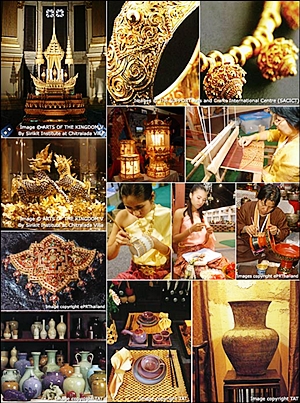
Traditional masterpieces can make collectors’ items to cherish. Many other crafts can be put to functional use as home and living accessories, gifts and art objects, fashion accessories or in other lifestyle applications such as hospitality.
Visiting handicraft workshops in their historic location adds deeper appreciation — even more so when visitors get the chance to try learning a craft skill.
Thai crafts fall into two main categories: court and folk.
Classical Court Crafts
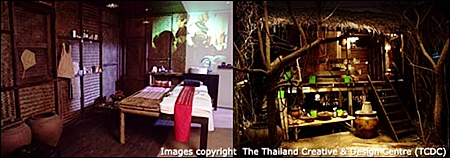
Royal artisans were commissioned by the court to create refined crafts for the palaces and royal temples. Known as chang sib mu, they were grouped into ten artistic skills, namely drawing, sculpting, figuring, moulding, turning, modelling, lacquering, plastering, engraving and beating. The chang sib mu tradition still continues.
Apart from temples and palaces, the easiest place to see these exquisite artifacts is Arts of the Kingdom, an exhibition in the Ananta Samakhom Throne Hall by the Sirikit Institute. The finery results from decades of work initiated by the Foundation for the Promotion of Supplementary Occupations and Related Techniques (SUPPORT) under the patronage of HM Queen Sirikit. The SUPPORT Arts and Crafts International Centre (SACICT) at Bang Sai in Ayutthaya province displays more remarkable exhibits.
Classical court crafts can be bought nationwide from the SUPPORT Foundation’s designated outlets, select shops shops, local fairs and consumer trade shows promoting Thai crafts, gifts and housewares.
Village Folk Crafts
Items crafted for domestic use and cottage industries are known as hatakam peun baan. These home crafts reflect the traditional village way of life or expressed tribal identity.
Made of natural materials from the surrounding area, the handicrafts include basketry, carpentry, earthenware, embroidery, appliqué, mulberry papier-mâché, garlanding, architectural carving, tool making and the dying and weaving of textiles.
Workshops are often open to visitors and some showrooms, especially in Chiang Mai, have artisans working on-site. Handicrafts can be bought nationwide from specialist shops, fairs, festivals, traditional provincial markets, floating markets and sales in Bangkok by the ThaiCraft organisation. Almost all crafts are represented at Bangkok’s Chatuchak Weekend Market. Many are also found at outlets promoting products under the One Tambon One Product (OTOP) campaign initiated by the Thai government to support the production and marketing of village crafts from various sub-districts, or tambon.
Many traditions struggle to survive in their original form, as technology, tastes and lifestyles change. However, visitors can still witness artisans making authentic goods the time-honoured way. Buying their crafts creates demand. This boosts interest in traditions and ensures that the skills get passed on to the next generation.
CRAFTS FOR MODERN LIFESTYLES
Applied Contemporary Crafts
Thai designers often apply craft skills and indigenous materials to their creations. These decorative elements are often incorporated into the design of hotels, spas or restaurants. Neo-traditional designs are stocked by boutiques – especially in Bangkok, Phuket and Chiang Mai – and at malls like Gaysorn, Siam Paragon or Siam Discovery. The Thailand Creative & Design Centre (TCDC) at the Emporium Bangkok shopping complex supports and often exhibits fine examples of Thai contemporary crafts.
Thai crafts can encapsulate memories of Thailand as souvenirs. The handiwork in more practical products also gives satisfaction with repeated use. Diverse Thai crafts can lend an ethnic accent to a modern lifestyle:
HOME WARES & DECOR
Basketry
Rattan, bamboo or reed provide versatile raw materials with which to make containers for a wide range of household uses: drying trays; wall panels; receptacles for farm produce; fish traps; market display trays and packaging; vendor panniers; hill tribe backpacks. In original form – or adapted with finishes like lacquer – basketry makes attractive storage containers, whether as a laundry hamper, magazine rack, bedlinen chest, wastepaper bin, receptacle for remote controls, or rummage box for toys. Some are used for light-diffusing lampshades, folding screens and blinds
Interior Decor
Thais used to live in multi-purpose wooden rooms with minimal furniture, but Thai crafts have ironically fuelled a wealth of furnishings, large and small. Triangular axe pillows, patchwork cushions and woven mats remain popular, while chic cushion covers feature local textiles, as do rugs. Intricate indigenous cloth also makes good wall hangings. Wood carvings are a staple for room display and can be commissioned to size. Basketry and ceramics easily serve as vases, bowls or lamp bases. Ratchaburi’s famous water jars and Mon pottery from Koh Kred have each had artistic reinterpretations. And one of the most aesthetically beautiful household tools is the humble Thai broom.
Gifts & Objet d’art
Refined crafts make impressive souvenirs or gifts purely for display. Stone sculptures from Dan Kwian, wooden carvings, clay figures from Chiang Mai, southern shadow puppets, Bangkok figure puppets, bronze rain drums, regional musical instruments, architectural motifs, pots clad in filigree yan lipao fibre from a vine fern found in the rainforests of southern Thailand. Some precious pieces may still find uses, such as exquisite betel boxes for storing jewellery. However, sacred items are not suited to secular use, such as monk’s fans or alms bowls hammer-beaten in Bangkok lanes.
COOKING & DINING
Kitchenware
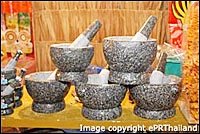
Thai cooking utensils developed with Thai cuisine, and many are still required for accurate flavours. You can tell a Thai kitchen by its elegant handmade equipment: finely woven fly-covers, round bamboo trays, forged-iron knives, tree-trunk chopping boards, earthenware charcoal burners and dimpled dessert griddles with ceramic lids.
Crucial in the preparation of Thai food are woven steamers for sticky rice and pestles and mortars made from stone or wood. Among the more charming but less essential items are coconut scrapers protruding from wooden stools carved to resemble animals.
Cutlery
New York’s Museum of Modern Art exhibits a set of Thai cutlery evolved from the blacksmith’s forge of Ayutthaya. Traces of the process of beating the blackened steel sheets remain in this muscular style of knife, fork and spoon. More delicate brass tableware evokes genteel dining in the late 19th century. Showpiece serving spoons come in many styles and forms, including lacquer, silver, coconut shell and carved wood. Thais adopted Chinese chopsticks to eat local noodles. The paired sticks have taken on elaborate forms including hardwood inlaid with silver, bone or mother-of-pearl, often with matching chopstick rests.
Crockery
Centuries ago, Si Satchanalai exported off-white Sangkhaloke pottery, with a blue fish motif still produced today. A more ornate porcelain of the Bangkok aristocracy, five-colour Benjarong with gold tracery, lends opulence to any dinner party. Northern kilns fire a heavier, but still genteel kind of dinnerware: celadon. Plates, cups and bowls come in the distinctive celadon green and other pastels, often with a finely cracked glaze as unique as a fingerprint.
Tableware
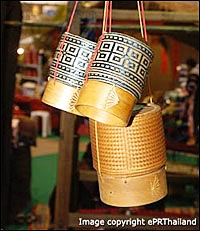
Thai food was traditionally cooked and served in banana-leaf containers, lotus leaf or bamboo tubes. Crafts now inspire many creative table-settings. Placemats come in myriad materials: lacquer; woven rattan or water hyacinth; beaten metal; loomed cotton or silk. Napkins showcase a range of Thai fabrics, while lengths of handwoven textile turn table-runners into a talking point. Candles and candle-holders have become a design genre in themselves.
Thais formerly drank from cooling metal bowls. Today’s embossed and engraved bowls of silver or aluminium make distinctive cups, finger bowls and serving tureens. Lidded rice bowls and distinctive Thai pedestal trays are crafted the same way. Sticky rice is still best served from interlocked bamboo baskets called krathip.
BATHROOM & SPA
Herbalism has always been a part of Thai life as food and for healing and promoting general well-being. Once endangered, the ancient lore and medicinal plants were revived through Thailand’s leadership in the global spa boom.
Herbalism
Apothecaries and markets still sell herbs loose or as supplements. Innovative companies have meanwhile been adapting old recipes of essential oils and plant extracts for use in creams, shampoos, tonics, soaps, balms, scrubs, cosmetics and other body products. Thai herbs such as prai also infuse candles, incense, pot-pourri and scent diffusers. From village remedies, these herbal cures have reincarnated into luxuriously packaged elixirs that transform a bathroom into a home spa.
Massage
The aromatherapy massage oils, liniments and steamed herbal compresses found in Thai spas make popular purchases. The reflexology tools carved from wood are particularly appreciated by those who learn Thai styles of traditional acupressure massage.
FASHION & JEWELLERY
Traditional Textiles & Ethnic Fashion
Thailand’s heritage of handloomed textiles reveals the country’s regional and ethnic diversity. Silks span from vividly ornate court gowns to the earthen tones of I-san pha khao ma loincloths. The patterns of handloomed cotton clothing typically indicated the wearer’s village or tribal origin, and sometimes their marital status.
Regional fabric’s vary from northern indigo used in maw hom outfits to I-san’s mutmee woven from tie-dyed threads, and southern batik.
Many local designers integrate traditional fabric into modern clothing, from shirts and skirts to scarves and ties. Thai cotton and silk share their hallmark of bobbly, uneven threads that make each piece individual. Other items feature natural dying or tribal appliqué.
Adornments
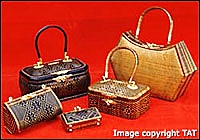
Accessories offer wider scope. Handbags act as a showcase for various crafts, from native fabrics to lidded boxes made from lacquer, silver, rattan, yan lipao reed, engraved nielloware or mother-of-pearl inlay.
Thai jewellery has roots in finely worked silver and gold, with prominent gem settings. Meanwhile tribal neck and earrings suit the trend in bold ethnic jewellery. Lightest of all are finery made from blue-green iridescent beetle wings.
HOSPITALITY & EVENTS
Thailand’s hospitality industry offers a platform for bygone skills to be revived and flourish. Many hotels, spas, restaurants and venues incorporate these crafts to impart Thainess in settings and at events like weddings and anniversaries to fire their guests’ imaginations.
Performed Crafts
Events often feature impermanent crafts which have a limited lifespan because each creation is performed live or made from perishable materials. These include floral art, fruit carving, cookery, ritual offerings and healing massage. This also applies to staged arts such as dance, puppetry, musical ensemble performances, and martial arts like muay thai boxing.
Performance also involves intricate artisanship in the costuming, masks, instruments, tools and other equipment. These crafts can often be seen being made in workshops where they are available for purchase as a dramatic decoration.
PARTICIPATE IN MAKING CRAFTS
Becoming increasingly popular is learning about Thai crafts through tours, workshops and specialist courses such as the Origin Arts Programme. Activities include fruit and vegetable carving, Thai cooking, floral arts, parasol painting, soap carving, textile dyeing, muay thai boxing, dance and the northern and central styles of Thai massage.
Floral Crafts
Flower garlands are the archetypal Thai offering. Incredibly complex, Thai floral arrangements are used for everything from tables, pedestals and floats to flower chandeliers and leaf bowers woven into animal shapes.
Fruit and vegetable carving
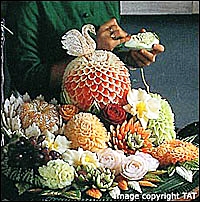
Visitors can take classes sculpting this classical serving decoration – and also apply the skill and specialist knives to durable candles and soap.
Cookery
The ultimate Thai craft is the most enduring: Thai cuisine. Recipes and cookery books cannot compete with learning Thai food alongside an experienced chef.
As with all Thai crafts, cooking requires a first-hand feel for local materials, instinctive measures, appropriate tools and the wisdom passed down through generations of masters.




